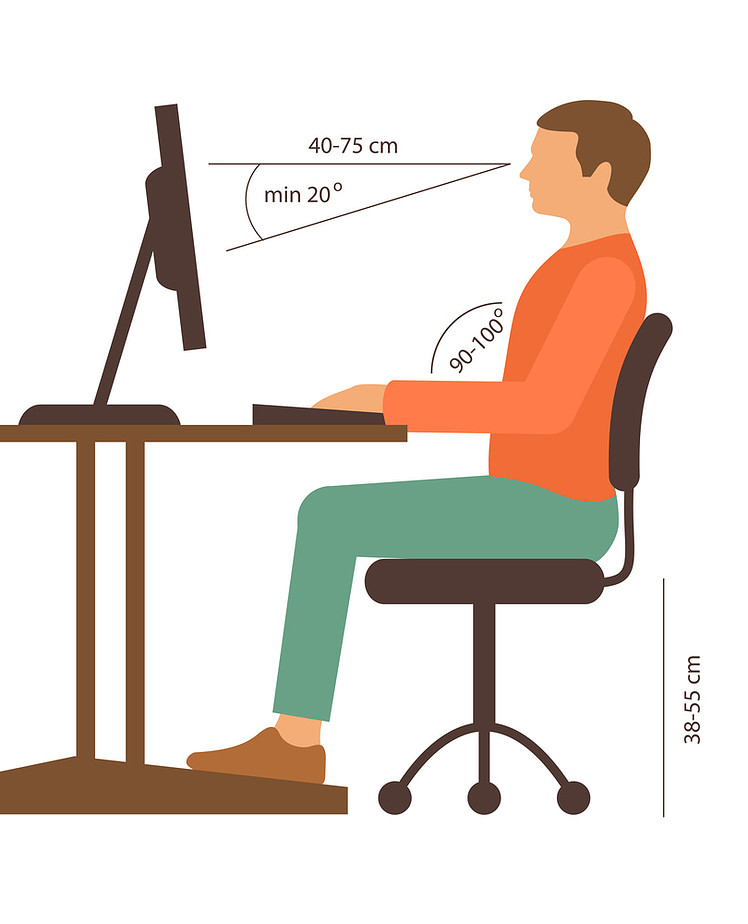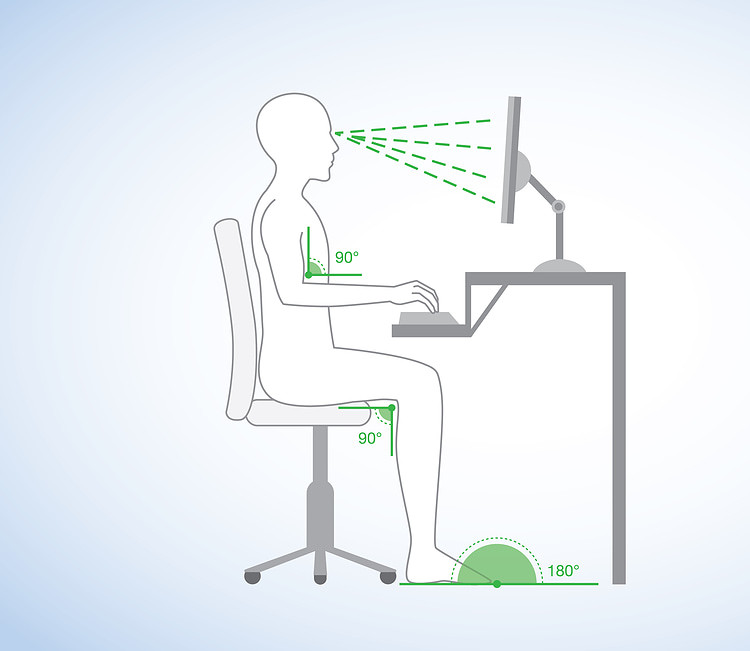With many people sitting in office chairs for 30 or more hours a week for their jobs, it’s important to have a comfortable office chair to keep your spine properly aligned, and your muscles relaxed.
Lumbar support as well as the proper height of the back of your chair can be extremely important when it comes to chairs of all types.
For many people, the question that comes up most often is how high should the back of an office chair be. You want the height of your seat to be adjusted high enough that your feet rest flat on the floor and the back of your chair should support the natural shape of your spine.
Table of Contents
How High Should My Chair Be At My Desk?

For most people of average height, around 5’8” to 5’10”, the best height for their desk is around 29 inches. This perfect desk height will be more or less for people of different physical heights, of course. When it comes to an office chair, there is no standard perfect height.
You want your office chair seat to be anywhere from 16-19 inches above the floor, depending on your physical height. Most office chairs can be easily adjusted in height to provide the most comfortable seating posture for the user. This chair height and desk height combination will allow you to sit straight and comfortably.
For people that stand 6 feet tall or taller, the best height for the seat of your chair should be 18 to 20 inches. Always sit in a natural position, with your feet on the floor and your back against the chair’s backrest. Adjusting the monitor on your desk to look straight ahead instead of up or down, can also help ensure your spine is properly aligned.
How Should I Adjust My Office Chair for Good Posture?

When you purchase a new office chair, it is very important that you take the time to ensure it is properly aligned to your body.
You don’t want to be forced to sit in the chair for hours daily only to find out later it’s poorly adjusted for your spine and pelvis. This can lead to back pain over time, affecting you for the rest of your life if not properly managed.
When sitting in an office chair, keep your feet flat on the floor in front of you. Ensure your legs are at a 90-degree angle with your knees at the same height or slightly lower than your hips. Keep your buttocks against the back of the seat and sit up straight. Your back should comfortably rest against the back of the chair.
Most office chairs have extra padding or a pillow specifically for lumbar support in your lower back. Ensure this feels comfortable to you and is not pressing on any nerves or causing additional pain.
Once all is adjusted to your liking, you can rest assured knowing your office chair is adjusted properly to your physical shape.
After properly adjusting your office chair and ensuring you have good posture, it’s important to be sure that your computer accessories are also adjusted.
For example, adjusting the placement of your keyboard and how your hands rest on the desk or armrests of the chair can help with shoulder pain.
Adjusting your monitor height and placement can also help with upper back and neck pain.
When you have to look up or down to a computer screen, this places strain on your muscles and spine leading to pain over time. By having your monitor at a comfortable level in front of your eyes, you eliminate the potential pain caused by having to look up or down unnaturally.
Where Should Back Support Be On An Office Chair?

Many office chairs are listed as being “ergonomic” which means they are specifically made to conform to your natural spine shape.
The spine rests in a gentle “S” shape and ensuring it remains supported during sitting is important. Ergonomic chairs are manufactured to help conform to this natural shape and provide support where it is needed most.
When it comes to ergonomics, lumbar support is important and the most common feature on a wide range of office chairs.
It’s normally built into the chair’s back or is included as a detachable pillow you can adjust manually. Normally, you will be able to adjust the height of the chair back yourself which will also adjust the lumbar support.
The lumbar area is your lower back. It sits just above your waistline, and this area of the spine normally bends inward.
Improper posture can cause you to slouch which puts the lumbar in an unnatural position leading to lower back pain over time.
Lumbar pain can affect your entire spine, so it’s always a good idea to ensure you do your best to prevent pain or misalignments in the first place.
Benefits of additional support

Some office chairs also have additional support near the shoulders. This can help align your muscles and reduce the amount of strain in your upper back. This is especially helpful for people that do a lot of drawing, craftwork, or keyboard typing.
Additionally, when you reduce the amount of strain placed on the upper back, it also helps keep the lower back aligned properly as well.
You may also find some more expensive office chairs that have headrests. This is great for neck support and can provide a comfortable way for you to lounge during downtime at your job.
Proper neck support can directly help with good posture and reduce the strain on your mid and lower spine.
Are High-Back Office Chairs Good?

High-back office chairs are somewhat uncommon in general. For the majority of workplaces that use office chairs for their employees, mid-back chairs are the norm.
High-back office chairs can offer additional support but can be slightly more difficult to adjust to your personal liking.
One of the biggest benefits of a high back office chair is adding additional support to your upper back, shoulder alignment, and neck support.
Most high-back office chairs do include a headrest or head pillow. This can usually be adjusted to provide full support to your entire body when working long hours sitting at a desk.
The spine is a complex skeletal structure and one misaligned section can cause problems throughout your entire spine. Having proper neck support creates a chain of comfort that affects everything below it including your mid-spine, lumbar, and pelvis area.
Additionally, having support throughout your entire spine comfort can encourage you to adapt to better natural posture.
Another benefit to high back office chairs is that you can lean back in them comfortably to relax during your downtime. The upper backrest and headrest provide full support to your entire spine.
Additionally, having a high back office chair is a much better option for taller individuals than using a low back or mid-back chair.
Conclusion

There is a wide range of office chairs available on the market today, and selecting the right one for your back comfort is important.
If you plan on using your office chair for extended periods of time, it’s highly important that you are comfortable when sitting in it. Your spine can easily become misaligned, causing lower back pain over time.
Additionally, a properly adjusted office chair can help improve your posture. If you’re comfortable when sitting in your chair, you will be much more inclined to lean back against the backrest, which can help ensure your spine is properly aligned.
Don’t be afraid to take your time to make sure the office chair you select feels comfortable to your body.
Adjusting the chair height and your desk height, monitor placement, keyboard placement, and having armrests can all lead to a perfectly comfortable experience while sitting in your office chair.

My name is Vance, and I am the owner of To Ergonomics. Our mission is to improve your workflow by helping you create a supportive and welcoming environment. We hope that you’ll find what you’re looking for while you’re here.

